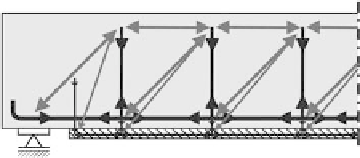Civil Engineering Reference
In-Depth Information
Fig. 5.4
Mechanism for transferring tensile forces from externally bonded reinforcement to
flexural
compression zone of member by means of truss action
As with externally bonded CFRP strips, an analysis to prevent a concrete cover
separation failure, see Section 3.4.3, is required for near-surface-mounted strips as
well. Tests (see [11, 54]) have shown that the method described in Section 3.4.3 can also
be used for members with near-surface-mounted CFRP strips.
In contrast to externally bonded CFRP strips, debonding at displaced crack edges does
not occur with near-surface-mounted strips because the bond behaviour is much more
robust. Therefore, the limit given in Section 3.4.1 for additional shear wrapping does not
apply for near-surface-mounted CFRP strips. With very high shear loads, however,
externally bonded shear straps must ensure that the tensile forces from the externally
bonded reinforcement can also be tied back the
flexural compression zone of the
member with the help of truss action, as Figure 5.4 illustrates.
The limit value
τ
02
to DIN 1045 [94] has turned out to be a suitable variable (see [29]) for
the maximum shear capacity without additional externally bonded shear straps.
Equation 5.9 expresses this limit (see [11]):
V
Ed
0
:
33
?
f
2
=
3
ck
?
b
w
?
d
(5.9)
If this limit value is exceeded, additional externally bonded shear straps are required to
con
ne the strips.
5.5 Fatigue analysis
When checking fatigue for non-static loads, the DAfStb guideline can again be used to
verify the bond of flexural strengthening in the form of near-surface-mounted CFRP
strips. As the carbon fibres exhibit virtually no signs of fatigue, only the bond needs to be
checked for fatigue when using CFRP strips. Besides the fatigue of the strengthening
system, the concrete, reinforcing steel and prestressing steel must also be checked
according to DIN EN 1992-1-1 [20] in conjunction with its National Annex [21].
In contrast to externally bonded CFRP strips, however, there is no comprehensive
analysis concept available for near-surface-mounted strips. Owing to the low number of
fatigue tests involving near-surface-mounted CFRP strips (see [27]), a quasi-fatigue
strength analysis is the only option here. With so few test results available, it is not
possible to specify an S-N curve for near-surface-mounted reinforcement. And as an S-
N curve is unavailable, it is not possible to extrapolate for a number of load cycles
greater than that given in the test results. Therefore, the analysis can only assume


Search WWH ::

Custom Search